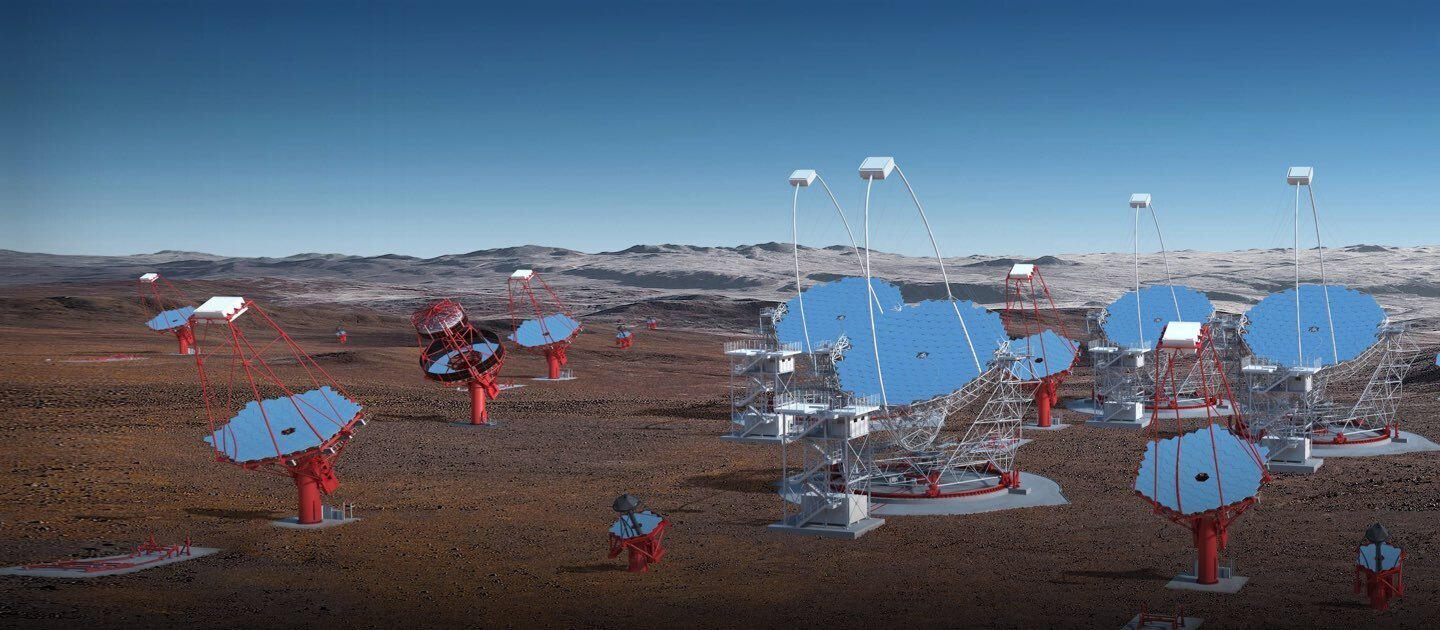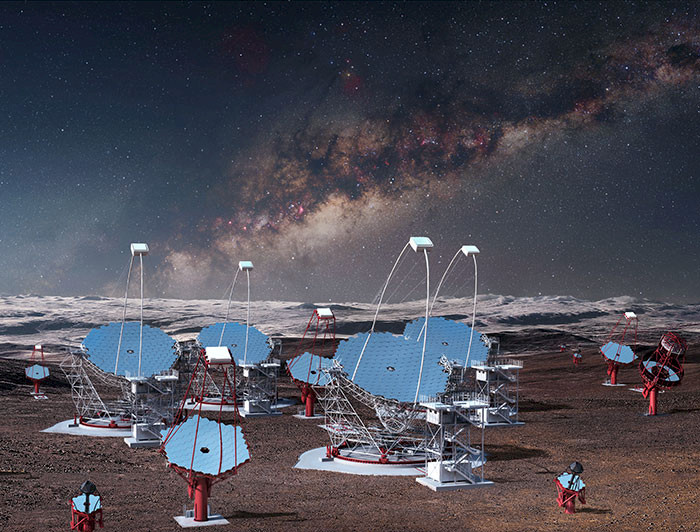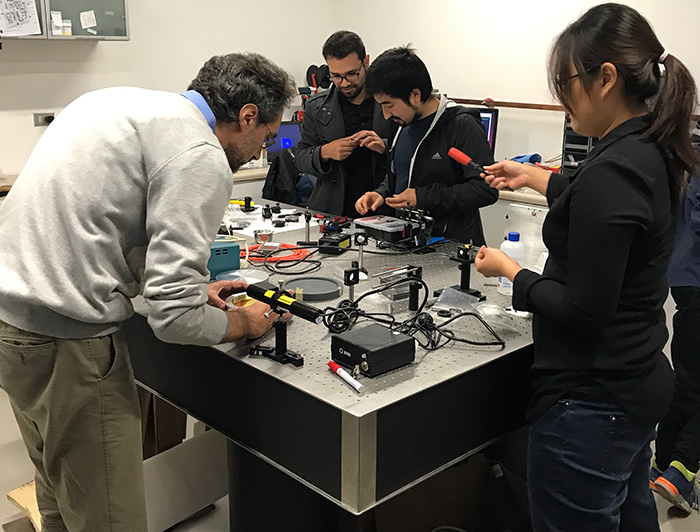
CTA-South Observatory: At the Frontier between Astronomy and Physics
The new CTA-South Observatory will be located in the middle of the Atacama Desert. It will be the first window to the high-energy universe installed in Chile and represents a new recognition of our country's territory's value in observing space. It is also a unique opportunity for interdisciplinary work between Astronomy and Physics.

photo_camera The "99 Cherenkov South telescopes" allow us to study the high energies emitted by: supermassive black holes, active galaxy nuclei, and supernova explosions, among others. It will help us to answer many unanswered questions. (Photo: Cherenkov Telescope Array 3D simulation)
To this day, the most energetic objects in the universe remain a mystery to humankind. We still have unanswered questions about:
- Supermassive black holes,
- Supernova explosions,
- Galaxy cores.
Soon, however, we will be able to unveil these secrets.
All thanks to a new generation of telescopes that will be installed in the north of our country. The new observatory called Cherenkov Telescope Array's southern hemisphere or CTA-South will be composed of 99 telescopes. It will be the largest and most sensitive instrument ever built to study astronomy and particle physics.
These nearly one hundred "eyes" will also allow two sister disciplines, astronomy, and physics, to work together.
Its instruments, especially its observation and data interpretation techniques, are very different from traditional optical telescopes. They will detect the secondary radiation produced in our atmosphere due to the gamma-ray shock from the objects mentioned above.
Its "brother" in the northern hemisphere,the CTA-North, in La Palma, Canary Islands, is already producing excellent knowledge. The CTA South will enhance it. Together they will provide a complete view of the universe.
According to Max Bañados, Dean of the UC Faculty of Physics: "This is a project that is on edge between Astronomy and Physics. It uses the methodology of Astronomy because the idea is to place telescopes looking at the sky. However, it will observe something very different from what an optical telescope does. It will concentrate on finding out where gamma rays come from, which are of very high energies, more energetic than ultraviolet rays."
Gaspar Galaz, faculty and former director of the Institute of Astrophysics, added: "The CTA project is the culmination of the systematic study of super energetic radiations coming from space. The blanket of many unresolved questions unfolds: What are the astrophysical processes that originate the most powerful radiations coming from space? Where do the famous cosmic rays, which have been detected for decades, come from, and how are they produced?"
Discovering the Invisible
The complex will be located in an area adjacent to Cerro Paranal, in the heart of the Atacama Desert, nested at 2,150 m. It will be adjacent to the site of the VLT (Very Large Telescope), one of the observatories of the European Southern Observatory (ESO).
From there, it will observe Cherenkov radiation. This radiation was named after the Russian physicist and Nobel Prize winner in Physics, Pavel Cherenkov, for being the first to characterize and explain its production.
This radiation is a consequence of the collision of gamma rays with our atmosphere.
"The radiation is generated by gamma rays coming from space and interact with charged particles (electrons) in our atmosphere. They are accelerated to a speed greater than the speed of light within the Earth's atmosphere. This produces Cherenkov radiation, which is observable at visible wavelengths," said Gaspar Galaz.
But where do gamma rays come from? In general, they come from the most energetic phenomena in the universe:
- Supermassive black holes
- Supernova explosions
These gamma rays collide with particles in our atmosphere and bounce back, so - fortunately - they do not reach the Earth's surface. Because of this, we cannot "see" them, only perceive the radiation they produce.
"We know that what our eyes see is not necessarily all there is. Galileo was the first to use a telescope to look at the sky, with which he managed to see the moons of Jupiter and other elements. Little by little, we have been observing the universe in different ways, in other channels and frequencies, obtaining more and more information. With these new instruments, it will be possible to see things that the human eye cannot see," said Max Bañados.
According to Christian Diaz, a physics Ph.D. student:
"What this telescope array will do is try to understand the high-energy physics at the frontier of the universe. It will detect energies that are so large that not even the particle accelerators on Earth can detect them. From the point of view of particle physics, it is a giant window to do theory. The objective of this pursuit is for these particles to give us an insight into physics that are still unknown," he said.
The site is expected to begin operations in 2025. It will be equipped with three classes of telescopes:
- Four Large-Sized Telescopes (LST): Each one will have a 23 m diameter parabolic reflective surface. It will weigh around 100 tonnes and capture the low-energy sensitivity of CTA.
- 25 Medium-Sized Telescopes (MST): Each one will have a reflector diameter of 12 m. It will weigh around 82 tonnes and cover CTA's core energy range.
- 70 Small-Sized Telescopes (SST): Each one will have a 4.3 m diameter primary mirror. It will weigh around 17 tonnes and cover CTA's highest-energy gamma rays.
A Great Opportunity for Science

Universidad Católica has been involved since the beginning of the project through the Faculty of Physics. First by making initial contacts seven years ago and then by being part of the CTA consortium. This group is made up of more than 200 institutions in 31 countries.
Chile was not the only option of building it, but eventually, it ended here. "We were very interested in having the CTA built in Chile. There was another alternative in Africa," said the dean of Physics, Max Bañados.
Today UC leads the Chilean scientific community of physics and astronomy, which is involved in the project. The group is made up of various universities:
- Universidad de Chile
- Universidad Federico Santa María,
- Universidad Andrés Bello,
- Universidad de Valparaíso,
- Universidad de Concepción,
- Universidad Católica del Norte.
Researchers from these universities meet in the "CTA Journal Club" group. Once a week, 20 to 30 researchers current topics in physics and high energy astronomy. From there, collaborations may arise from the studies developed at the new observatory.
This "is a great opportunity for the astrophysics community in Chile," said Gaspar Galaz. He has participated since the beginning of the project.
"This is the first of several telescopes installed in Chile in the last 50 years, which has garnered the interest of both the astronomer and physicist communities."
This observatory is of particular interest to physicists working in high energy areas:
- Particle physics
- Theoretical and experimental high-energy physics
- Theories of gravitation and dark matter, among others
Also, it is interesting for those astronomers that study astrophysical processes where phenomena that emit particles and gamma rays of high energy are generated:
- Active nuclei of galaxies
- Supermassive black holes (over 1 million solar masses)
- Collisions of compact astrophysical objects such as neutron stars or supernova explosions that produce gamma-ray jets
- Any other gamma-ray growing phenomena, the nature of which is not yet fully determined
The CTA will make it possible to develop a new area of physics: "Astroparticles, which mixes particle physics and high energies, with observation, which is the window that shows us nature," explained Christian Diaz.
"Chile is by far the most important country in observational astronomy, and now it is going to have particle physics added to it. This installation is going to put the country at the forefront of high-energy astrophysics."
Like with the other observatories built in Chile, our scientists will have 10% observation time.
"This is an enormous privilege, and it can mean a great opportunity to boost both particle physics and other areas of this discipline," said Max Bañados.
He concluded: "It's a great opportunity for astronomy to come out of its world and flood physics, with all the possibilities that this implies. I hope we will all be able to take advantage of this great natural laboratory that we have."


